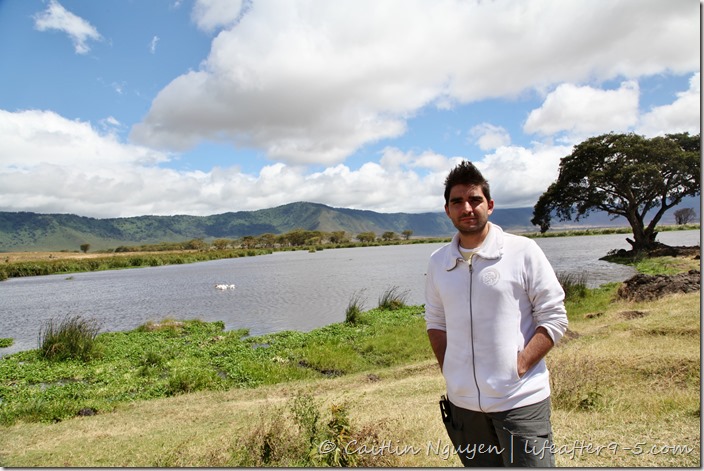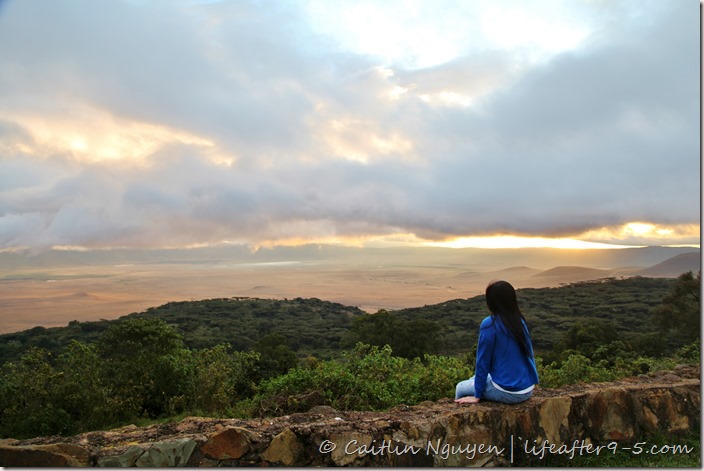
Tanzania is the birthplace of the human race. It’s where they found the first human skull. If you believe in Charles Darwin’s theory of evolution, this is where our ancestors evolved and the first humans walked across the Serengeti plains; hunted, gathered, survived, and evolved millions of years ago. “There is something about safari life that makes you forget all your sorrows, and feel as if you had drunk half a bottle of champagne – bubbling allover with heartfelt gratitude for being alive .” (Karen Blixen – Out of Africa)

On our fourth day we said goodbye to the Serengeti and headed over to the highlands of Tanzania. Ngorongoro, a designated UNESCO World Heritage Site, was formed when a large volcano exploded and collapsed on itself millions of years ago. It became the the world’s largest inactive, and unfilled volcanic caldera. The name Ngorongoro is from the Maasai meaning Gift of Life. The Ngorongoro Crater and surrounding highlands together form one of Africa’s most beautiful regions.


As you ascend to the higher elevation, the air starts to get noticeably cooler than on the plains. Up at the top of the rim the temperature dropped even further, and I needed several scarfs and a jacket to keep warm. I stood at the edge, and rubbed my arms vigorously to keep warm as I admired the the vast expanse of the crater below.



The winding drive into the crater is spectacular. From the inside, the view is just as lovely. The surreal landscape with its soft pastel colors provides the perfect backdrop to the grazing animals. Inside the crater is even more enormous and stunning than from above.


The Ngorongoro Conservation Area is mostly occupied by the Maasai tribes. These tribes have evolved over years from hunter-gatherers to become the pastoralists today. Humans are not allowed to live within the crater; so the tribes set up camp in the surrounding area, but make the daily hike over and into the crater with their livestock to collect water. The many small springs found around the caldera floor are important water supplies for the wild animals as well as the Maasai, especially during times of drought. Only in the spectacular Ngorongoro Crater, you’ll find wildlife coexisting with the semi-nomadic Maasai tribes.

There is a large seasonal salt lake in the center of the crater, home to many flamingos. However, since we went at the end of the dry season, the water had mostly evaporated and the lake receded further from the road. We were only able to see the tiny pink flecks in the distance.




The volcanic basin has some of the most fertile grazing grounds in Africa. The idyllic landscape is filled with plenty of wildlife like zebras, cape buffaloes, wildebeest, and ostrich. The unique geography of the area also provides protection for the animals from outside threats.


A side effect of the crater being a natural enclosure is that the lion population is significantly inbred. The male lions are very territorial and often eliminate outside competitors from coming in. This severely limits new bloodlines from entering the local gene pool. While driving around, we saw a pride of lions hunting buffalo. The male lion was sleeping in the distance while the females slowly encircled their weary prey. Every time the buffaloes grazed further away, the lions would follow in a dangerous game of cat and mouse. The lions have derived ingenious signals using tail and ear gestures to communicate to each other while they are on the hunt.

A rhino sighting is quite rare because they are almost extinct from the constant poaching. We spent hours stalking a rhino to no avail, and Fausto said at this point spotting a rhino would be like seeing a unicorn (he thinks he’s so funny). Finally after many hours, we saw one from afar lying and napping. We waited hoping that it would get tired of sitting around and move closer. After an hour, it stood up for 5 minutes before sitting back down again.


The other major water source in the crater is the Ngoitokitok Spring, near the eastern crater wall. The spring feeds into a large fresh water lake, where we parked and had our picnic lunch. The area is inhabited by hippopotamus, zebras, and lions; but we only saw some pelicans and hippos swimming around in the water. The weather here is fickle, it can be sunny and spritzing and windy all at the same time. We had our daily chicken sandwich and walked around to stretch our legs.


As the afternoon wore on, a massive cloud came out of nowhere and swallowed up the crater, picking up moisture from the surrounding lakes. It cast a dark shadow over the valley below. One minute there was sunny blue sky, and the next minute it was dark and threatening.


At the end of the day, we headed up to the Sopa Lodge, our home for the night, located at the highest point of the rim overlooking the entire crater. The unparalleled vantage point faces West, providing an unforgettable view of saffron-hued sunset over the vast caldera below.




Wonderful
LikeLike
Thank you so much!!
LikeLiked by 1 person
I love your blog outstanding work.
-Rustic Traveller-
LikeLike
I really appreciate the positive feedback! Thank you for reading and following 🤗
LikeLike
The Ngoronogro Crater was probably my favorite part of my African safari and you did a fabulous job showing off it’s beauty! Sometimes pictures are much better than words. Love your photos.
LikeLike
Thank you so much!! The scenery is so beautiful, but we didn’t see as many animals as in the Serengeti. I think we probably went at the wrong time.
LikeLike
They are! I can look at pictures forever and it’ll instantly bring back the memories. Thank you so much!
LikeLike
Beautiful photos! I loved Ngorongoro and esp. the Sopa lodge! Such a stunning location…I miss Tanzania now.
LikeLike
Me too! I want to go back again. Maybe climb Kili next time?
LikeLike